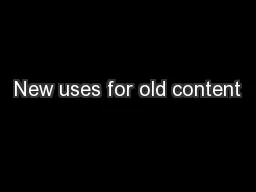

Dr Adam Farquhar Head of Digital Scholarship The British Library bldigital http britishlibrarytypepadcoukdigitalscholarship 150 Million Items Digital Content But still chained ID: 141098
Download Presentation The PPT/PDF document "New uses for old content" is the property of its rightful owner. Permission is granted to download and print the materials on this web site for personal, non-commercial use only, and to display it on your personal computer provided you do not modify the materials and that you retain all copyright notices contained in the materials. By downloading content from our website, you accept the terms of this agreement.
Slide1
New uses for old content
Dr Adam FarquharHead of Digital ScholarshipThe British Library
#
bldigital
http
://
britishlibrary.typepad.co.uk/digital-scholarship
Slide2
150 Million ItemsSlide3
Digital ContentSlide4
But still chainedSlide5
“Literary scholars and historians have in the past been limited in their analyses of print culture by the constraints of physical archives and human capacity.
A lone scholar cannot read, much less make sense of, millions of newspaper pages. With the aid of computational linguistics tools and digitized corpora, however, we are working toward a large-scale, systemic understanding of how texts were valued and transmitted during this period”David A. Smith, Ryan Cordell, and Elizabeth Maddock Dillon, ‘Infectious Texts:
Modeling Text Reuse in Nineteenth-Century Newspapers’ (2013) http://www.ccs.neu.edu/home/dasmith/infect-bighum-2013.pdfSlide6
“Reading individual works is as irrelevant as describing the architecture of a building from a single brick, or the layout of a city from a single church
”Franco Moretti, StanfordSlide7
Digital Research Team
Cross-disciplinary mix of curators, librarians and programmersSupport innovative use of our digital collectionsExplore how digital technologies are re/shaping research and how this informs how the library does its business
Encourage and support colleagues & scholars to work with
and across the
library’s
digital contentSlide8Slide9
http://samplegenerator.cloudapp.net
Labs 2013 Competition Winner
Pieter Francois - postdoctoral researcher at the University of Oxford
Focus on European travel in the 19th Century
Uses statistical methods to support text analysis
Tool produces representative samples of texts based on search criteriaSlide10
Labs 2014 Competition Winners
Desmond Schmidt and Anna Gerber of the University of QueenslandFor: Text to Image Linking ToolLinks transcriptions to manuscript regions
Bob Nicholson of Edge Hill UniversityFor: Victorian Meme Machine
What would make a Victorian joke funny again?Slide11
Off the Map Competition 2013
A challenge for videogame design students to turn historic maps and engravings from the British Library collections into a 3D environment using Crytek's CRYENGINE software.
Pudding Lane Productions, a team of six second-year students from De Montfort University, Leicester, won first prize.
Their work was showcased at GameCity, an annual festival of videogame culture.
http://youtu.be/SPY-hr-8-M0
(Flythrough starts at 0:50)Slide12
Images
from Delineations of Fonthill and its Abbey, John Rutter, 1823 Off The Map Competition 2014
Terror and Wonder: The Gothic ImaginationExhibition opens October 2014
Fonthill
Abbey, home of William Beckford, author of
Vathek
Edgar Allan Poe’s Masque of the Red Death
Whitby and its association with Bram Stoker’s novel DraculaSlide13
Microsoft Live Search
e
arly foray into mass digitisation
Digitised 65,000 out of copyright books from the 19
th
Century from 2006 – 2008
In the public domain!Slide14Slide15Slide16Slide17
Launched December 13
th, 2013Over 160 million image views Over 90,000 unique tags added; 4000 portraits, 3000 maps, 600 music
Top tagger a story of Machine (15K) vs. Man (30K)! By the numbers Slide18
Creative Uses
David Normal installation at Burning Man Festival
“Moments” by Joe Bell
Colouring-in Pages for ChildrenSlide19
Research
Mario
Klingemann
Pattern Recognition Software
Lost Visions: retrieving the visual element of printed books from the nineteenth century’ Julia
Thomas, Cardiff University
Collaborative PhD
‘A History of the Printed Image 1750-1850: Applying Data Science Techniques to Printed Book Illustration’
And
more…
TSB Digital
Innovation Contest
- tracking
Public Domain in the
WildSlide20
Crowdsourcing & Apps
Metadata Games
Wikipedia Synoptic Index Slide21
Tutorials
Using Photoshop to Up-res images
Converting images to vector graphicsSlide22
Collaborations with Colleagues
Inspired by Flickr, a Sound Archive series Maps will be fed into the next phase of the
Georeferencer Slide23
Education
Images included in Wikipedia ArticlesUniversity of Minnesota English Literature Course Exercise on Tagging
Art Therapy Courses Slide24
Commerce
Possible tie-in with British Library Shop.
Skateboard on Zazzle by Jon Voss, HistoryPinSlide25
Big Data ExperimentJoint project with UCL, Microsoft and the BL
UCL Computing MSc students will develop experimental platforms to interrogate public domain digital collections Use Microsoft Azure cloud infrastructureLearn about research patterns in the arts and humanities
Grapple with public domain digital collections
Implement researcher tools and services in Azure
Image recognition, machine learning,
statistics
More at http
://bit.ly/1kZ0oKvSlide26
Thank you
#
bldigital
http
://
britishlibrary.typepad.co.uk/digital-scholarship
©2014 Adam Farquhar. This work is licensed under a Creative Commons Attribution 3.0
Unported
License. Suggested attribution: “This work uses content from "New uses for old content" © Adam Farquhar, used under a Creative Commons Attribution license: http://creativecommons.org/licenses/by/3.0/”